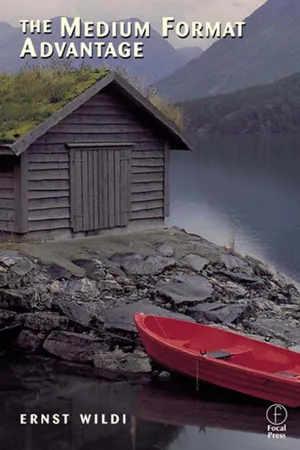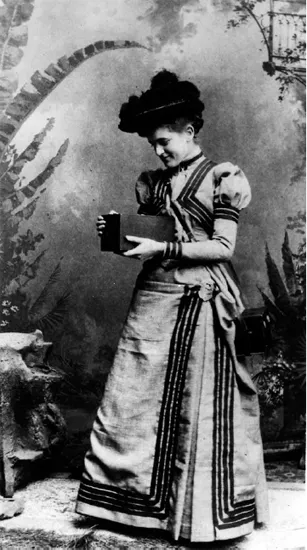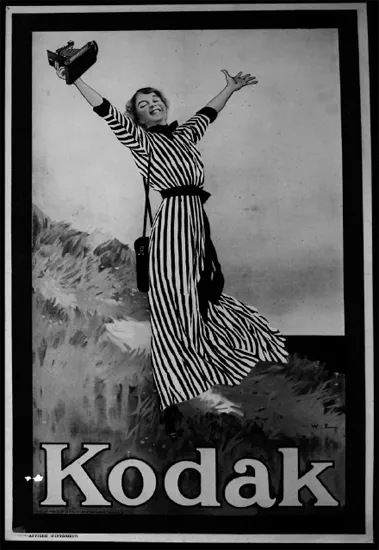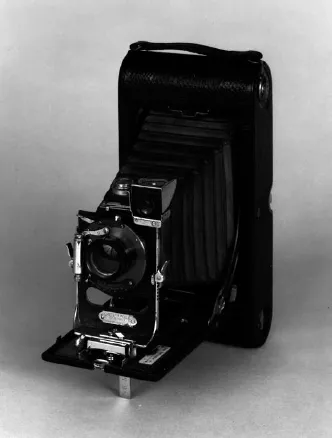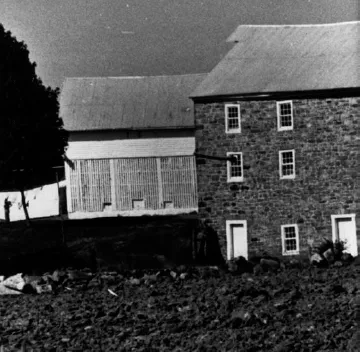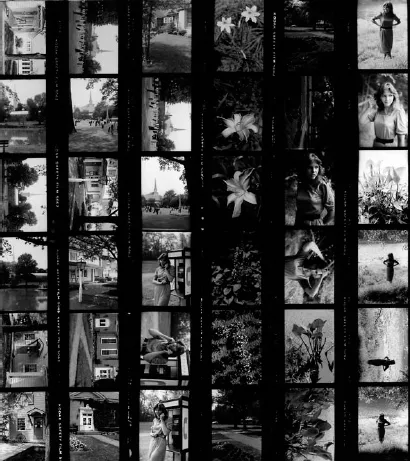![]()
CHAPTER 1
The History of the Medium Format
“Medium format” as it is defined today—“to categorize the film formats between 35 mm and the larger view camera formats 4 × 5 in. and up—”is frequently considered quite new.
But photography actually started with the medium format. The daguerreotype plates used in the 1840s were 6 1/2 × 8 1/2 in. large. But since silver and copper, the components of these plates, were very expensive, the image often did not cover the full size of the plate, so the plates were split into smaller sections (1/2 to 1/16) such as 2 3/4 × 3 1/4 in., 2 1/8 × 3 1/4 in., or 1 5/8 × 2 1/8 in. Judging from the large number of photographic images that have survived from this time, the 2 3/4 × 3 1/4 in. “medium format” was the most popular.
Roll film, which forms the basis for the design of the modern medium format camera, appeared in 1888 when George Eastman introduced the first camera with the Kodak name. The camera was factory loaded with roll film for 100 exposures, and the entire camera had to be returned to Eastman for processing the finished roll of film and for reloading. The image size on the negative was a 2 1/2 in. circle.
The medium format took a giant step toward becoming the most popular film format for years to come when the Box Brownie appeared on the market in 1900. Eastman hoped that with the price tag of $1, the camera would fulfill his dream to bring photography to every schoolchild. The Brownie also ushered in today’s most popular medium format, the 2 1/4 in. square, which was produced in the Box Brownie on a cartridge of 117 roll film with six exposures. The cost was 15 cents.
In one of the early photographic promotion pieces, the Kodak camera was shown handheld to emphasize its compact size. Photographers simply aimed these early “handheld” cameras at the subject, because the cameras didn’t have a viewfinder. Courtesy International Museum of Photography at George Eastman House.
The original Box Brownie made in 1900 with a 105 mm f/17 lens. The film support box at the rear was removable with a hinged panel in later models. Six 2 1/4 in. square images were produced on roll film. Cameras with the Brownie name were produced until 1965. Courtesy International Museum of Photography at George Eastman House.
The 120 roll film, which is the film mostly used in today’s medium format photography, dates back to 1902, when it became a popular type for producing 2 1/4 × 3 1/4 in. images in Brownie and folding cameras. Other popular roll film sizes were (or still are) 127, introduced in 1912, and 620, which dates back to 1932. Brownie and folding cameras of many types and makes using the same type of film remained the amateur camera until the 1930s, to be replaced eventually by the twin lens types, and later by the single lens reflex (SLR)
There were twin lens reflex (TLR) cameras before 1900, but the TLR era was really born in 1929 with the appearance of the Rolleiflex. It was fast handling and compact, with a crank to advance the film. TLRs were immediately recognized as excellent tools, falling between the slow-handling larger format models and those using the small 35 mm film, which also established itself in the 1920s. Serious photographers recognized the Rollei advantages, and the camera became one of the most successful types of all time. The success also brought competition. Other companies, especially Zeiss and Voightländer, introduced TLR models. The success also brought about a Rolleiflex for the 40 × 40 mm format, today known as superslide.
By the early 1900s, Kodak promoted photography as a hobby for everybody everywhere. Female models were used, perhaps to emphasize that the camera had become so lightweight and so simple that everyone could operate it. The outdoor location emphasized that photography was no longer limited to the studio. Courtesy International Museum of Photography at George Eastman House.
A 1903 Kodak Model 3A folding pocket camera with Bausch & Lomb 170 mm f/4 lens with iris diaphragm. The waist-level finder was reversible for horizontal and vertical framing. A plate back accessory for ground-glass focusing and dry plates were available for some models. Courtesy International Museum of Photography at George Eastman House.
SLR cameras for large film sizes date back to 1880. In the 1930s, Graflex captured a large part of the market by introducing a small model with interchangeable lenses made for 10 pictures on 120 roll film.
A milestone in medium format camera design came in 1948 when Victor Hasselblad showed his 1600F model. It not only had a new medium format shape, but also was equipped with an interchangeable film magazine, which is the main attraction of the modern medium format SLR camera.
The panoramic image also started in the medium format. In 1899, Kodak introduced the Panoram-Kodak camera 4. It had a swinging lens producing a “large” 3 1/2 × 9 in. image on 103 roll film. The panoramic
camera design came down to a more normal medium format in 1900 with the Kodak 1 Panoram camera. It produced 2 1/4 × 7 in. images on 105 roll film. While there are various panoramic cameras for 120 and 220 film available today, the most popular panoramic camera, the Hasselblad XPan, produces an image 24 × 65 mm on 35 mm film. In a way, this camera can also be considered a medium format type since its image diagonal is equal to that of the 6 × 4.5 cm format and the camera’s lenses are medium format lenses with a covering power for the 6 × 4.5 cm format.
In almost 150 years of photography, some film formats have disappeared completely or are no longer used in some fields of photography; others have appeared and gained in popularity. But the medium format has been in constant use in almost any type of camera and, today, is still the chosen film size for professional photographers working in almost every field, as well as for amateurs.
Today the medium format includes everything between the small format (35 mm and smaller) and the larger formats (4 × 5 in. and over) and is somewhat of a compromise between the two. It combines many of the conveniences of 35 mm with the benefits and advantages of larger studio cameras. That is the reason it is so popular and so valuable in almost all types of photography.
![]()
CHAPTER 2
The Medium Format Advantages
IMAGE SHARPNESS
Thirty-five millimeter and medium format cameras use the same type of black-and-white and color films. Because the medium format negative or transparency is anywhere from two and a half to four times larger in area than the 24 × 36 mm frame, its sharpness is proportionately better. To look at it in another way, the medium format negative can be blown up proportionately larger (to 30 × 40 in. instead of 16 × 20 in.) while retaining equal quality, assuming everything else is equal.
Since the quality, especially the sharpness, of films has been improved drastically over the last few years, some people have commented that the 35 mm image quality is completely satisfactory for any application where the medium format was originally needed or suggested; that it is no longer necessary to move up to the medium format. True, 35 mm negatives can today be enlarged to greater sizes without looking grainy or fuzzy. But since the same emulsions are used for both the 35 mm and the medium format, the same quality differences still exist between 35 mm and 120 roll film. The medium format image is still better.
In my mind, it is exactly the fabulous sharpness of today’s films that is the best reason for moving up to the medium format. Medium format photography should be more attractive to the serious photographer because only the larger medium format images can truly convey the superb sharpness that is possible on these emulsions.
You will be greatly excited about the photographic image quality of the medium format when you examine the original 2 1/4 negatives or transparencies under a 10× magnifying glass and compare them with 35 mm originals. The 35 mm images might look great, but you probably would love to see the same image two and a half times to four times larger so you can really see the details that only the medium format image can reveal to you.
Prints made from almost any size negative are salable, and 35 mm transparencies are also accepted for most purposes, but the medium format images are still preferred or requested in many fields for advertisements and editorial purposes. By presenting the larger medium format transparencies, you will have a definite edge over your 35 mm competitors with many clients and art directors. You will convey a professional image and make a good impression on clients, who will be better able to see the results and determine how the image will fit into the advertising layout or design.
Although the 35 mm format cannot approach the sharpness of the medium format enlargement, or the beauty and effectiveness of a medium format slide presentation, image sharpness and effectiveness are not necessarily the major reasons for stepping up to the medium format. Other benefits of the medium format are even more helpful and valuable.
The larger medium format image can truly convey the quality of today’s high-resolution films. Note the exceptional sharpness of the white window frames, which is maintained even in the 10× blow up on the next page.
It is the edge sharpness of such lines that conveys to our eyes the impression of sharpness.
IMAGE EVALUATION
It is often said that once you work in the medium format, you’ll never go back to 35 mm, probably because the medium format negative or transparency is easier to evaluate. For example, when a 35 mm and a medium format negative or transparency are placed side by side over a light box, the effectiveness, even the quality, of the medium format negative can be determined more easily, usually with the naked eye. There is no need to use a magnifying glass except to determine critical sharpness. Cropping possibilities also can be determined effectively and accurately.
Medium format is also conducive to working with contact sheets, a favorite method of proof printing 35 mm and medium format negatives. Such proofsheets make it easy to compare images taken of the same subject or in the same location in order to select the best and decide on the final cropping. Differences in pose, lighting, expression, depth of field, composition, and even sharpness can be detected easily and usually without the use of a magnifying glass. The 35 mm contact proof images are frequently too small for this purpose. This is why many 35 mm photographers have the more expensive enlarged proofs made. The twelve 2 1/4 in. square or sixteen 4.5 × 6 cm images from a 120 roll film also fit well on a single sheet of 8 × 10 in. paper.
Proofsheets also provide a simple way for filing negatives. Negatives in their protective envelopes can easily be stored next to the proofsheet in a ring binder or filing cabinet.
The 12 images on the 2 1/4 in. square (above) or the 16 images on a 6 × 4.5 cm proofsheet are large enough to be evaluated carefully with the naked eye. Possible changes in the image format can also be determined easily. This is more difficult or impossible with 35 mm contact proofsheets (right). A 35 mm proof-sheet also needs to be turned to see verticals and horizontals properly.
FOCUSING SCREEN
The focusing screen size must be among the medium format considerations.
On any SLR or TLR camera, the focusing screen is the size of the negative; consequently, the medium format focusing screen is anywhere from two and a half to four and a half times larger than its 35 mm counterpart. The larger screen does not necessarily provide more accurate focusing, but a more effective image evaluation, and you may be able to do so without needing to use a ma...
